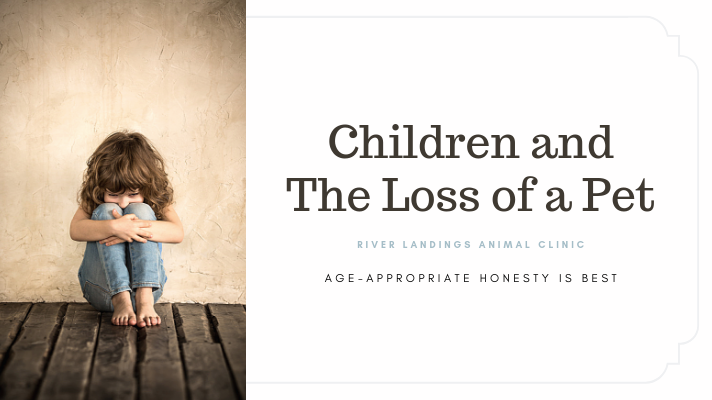Dealing with the loss of a pet is never easy. When dealing with the sudden loss due to an emergency illness or injury, or euthanasia, the decisions that must be made and the ultimate loss of the family pet bring up a lot of conflicting and difficult emotions.
When children are involved, special considerations must be made to help them understand what is going on and how to deal with the loss of a pet and grief that follows.
Preparing for Euthanasia
Euthanasia is “death by injection” for a terminally ill, suffering animal. Many people refer to this as “putting an animal to sleep”. The finality of death is a difficult concept, especially for children. Children can be confused and even frightened by the term “putting to sleep” if they see the lifeless pet after the euthanasia is performed.
When preparing for an appointment to have a terminally ill pet euthanized, it is best to speak in honest terms, at an appropriate level of detail for the child’s age. Very small children need to know that this is final — the pet isn’t going to wake up or come back. To say that the pet “went away” or is “in heaven” without offering any other details can also confuse children. Older children need to know the reasons why this decision is being made, and why it is humane for the suffering animal.
To be or not to be present at the actual euthanasia is a question many adults grapple with. This is a personal decision and one that should be discussed with your veterinarian. It is common practice that children under a certain age are not allowed to be present for the actual euthanasia. Children, especially under the age of 5, have a hard enough time understanding the concept of death and witnessing the event does not make it easier to understand or cope.
It is important to realize that when humans (adults and children) are upset, the pet is, too. While difficult, it is important that the humans try to lend support and comfort their animal friend in this last time of need. Seeing their humans upset may upset the pet, too.
Sudden Death or Finding a Pet Dead
For situations where the animal is fatally injured or is found dead from unknown causes, children need to be assured that the animal is no longer in pain. The shock can be more emotional than a “prepared for” death. If veterinary care was attempted, the child should be reminded that sometimes pets don’t survive, despite the attempts to save them.
Signs of Grief in Children
Children may take longer to grieve or “get over” the loss of a pet than adults. A short time of depression, acting out, or gloominess can be expected and should go away. Longer periods or abnormal activity following loss should be addressed by the parent, a counselor, or a grief/loss support resource. Warning signs of severe or prolonged grief will vary significantly with the variables of the child’s age, relationship with the pet, emotional maturity, circumstances involved with the death, and so on, but here are some general guidelines for recognizing grief in children:
Not interested in usual activities, withdrawing from friends and family
Eating considerably less than usual
Reverting to pre-potty training or bedwetting
Afraid of being alone or going to sleep, nightmares
Preoccupied with thoughts of death
Talking about the death of a pet with your child is a good first step. For more assistance and guidance, know that there are many grief and loss support resources and hotlines, many of them free of charge, available online and over the phone.
Moving Forward and the Time to Heal
Remembering the deceased pet
It is important to never belittle or ignore the child’s relationship with the deceased pet. To say that it was “just a goldfish, and we can get a new one tomorrow” dismisses the importance of the human-animal bond and does not address the child’s grief. Children often have imaginary friends that warrant conversations and emotions. Pets are real. They warrant true feelings and emotions, too. Take the time to remember your pet with your kids and do something special to help them navigate their feelings.
Closure
Having a burial, memorial, or similar ceremony helps to reinforce the importance of the pet’s life and mark the death event. Children should be allowed to participate in whatever way is appropriate. From helping mark the grave site, decorate the urn of ashes, or draw pictures of happy times together with the pet—whatever activity best fits with the child and allows them to say goodbye in their own way.
Getting a new pet
Getting a new pet is a very personal choice. Children should not be rushed into getting another pet to help them “get over” the deceased pet. One pet does not replace another, and getting a new pet too soon may only cause the child to resent or even mistreat the new pet. Only once a child can speak openly about a deceased pet and shows interest in a new pet should the subject of a new pet be discussed.
Dealing with the loss of a pet is never easy, but you are not alone. There are many grief/loss support resources available.
Hear From Us Again
Don't forget to subscribe to our email newsletter for more recipes, articles, and clinic updates delivered to your inbox (here). Or, you can keep up to date by liking and following our Facebook page (here).
Related: We have more information under our client care tag.



